Four events were contested in archery at the 1988 Summer Olympics in Seoul. These events included team competitions for the first time in modern Olympic archery. Men's and women's individual competitions continued to be part of the schedule as well.
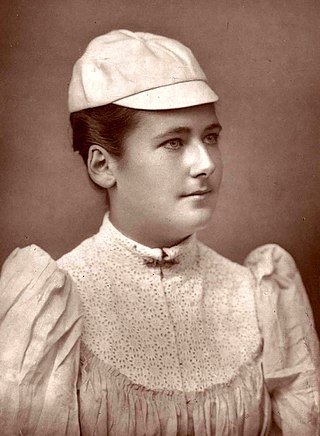
Charlotte Dod was an English multi-sport athlete, best known as a tennis player. She won the Wimbledon Ladies' Singles Championship five times, the first one when she was only 15 in the summer of 1887. She remains the youngest ladies' singles champion.

Archery at the 2004 Summer Olympics was held at Panathinaiko Stadium in Athens, Greece with ranking rounds on 12 August and regular competition held from 15 August to 21 August. One hundred twenty-eight archers from forty-three nations competed in the four gold medal events—individual and team events for men and for women—that were contested at these games.

Archery had its debut at the 1900 Summer Olympics and has been contested in 18 Olympiads. 105 nations have competed in the Olympic archery events, with France appearing the most often at 15 times. The most noticeable trend has been the excellence of South Korean archers, who have won 32 out of 44 gold medals in archery events since 1984. Olympic archery is governed by the World Archery Federation. Recurve archery is the only discipline of archery featured at the Olympic Games. Archery is also an event at the Summer Paralympics.
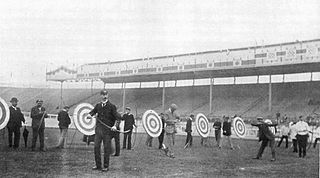
The men's Continental style was one of three archery events on the Archery at the 1908 Summer Olympics programme. The event was held on 20 July. NOCs were limited to 30 competitors each, though none came close to this maximum.
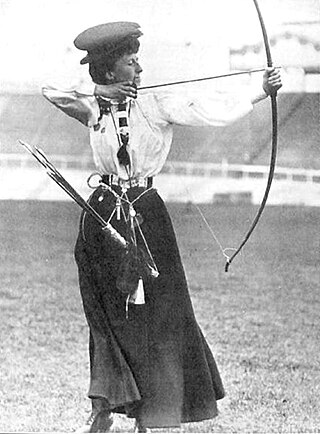
The women's double National round was one of three archery events on the archery at the 1908 Summer Olympics programme. The competition was held on Friday, 17 July and Saturday, 18 July, with one round each day. The archers had to contend with significant rain and wind on the first day and gusts of wind on the second.

The men's individual revolver and pistol competition was one of 15 shooting sports events on the shooting at the 1908 Summer Olympics programme. The competition was held on Friday, 10 July 1908. Each nation could enter up to 12 shooters. Forty-three sport shooters from seven nations competed. Nations were limited to 12 shooters each. The event was won by Paul Van Asbroeck of Belgium, with his countryman Réginald Storms taking silver. They were the first medals for Belgian shooters in the free pistol. American James Gorman finished with the bronze medal after an unsuccessful protest, claiming he had put one bullet through a previous hole.
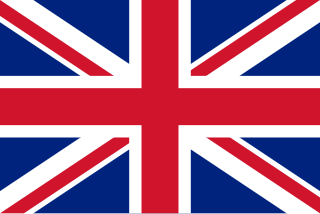
Great Britain, represented by the British Olympic Association (BOA), competed as the host nation of the 1908 Summer Olympics in London. The British Olympic Association was the National Olympic Committee responsible for organising the United Kingdom's representation. At the time British athletes competed under the team name "United Kingdom". The British team comprised 676 competitors.

William Dod was a British archer. He won the gold medal in the men's double York round at the 1908 Summer Olympics on his 41st birthday.

Reginald Brooks-King was a Welsh archer. He was born in Dixton, Monmouth, Wales, to James Pearce King and Katherine Bagnall. He won the silver medal in the men's double York round at the 1908 Summer Olympics. Brooks-King shot a 393 in the first round of the competition, held in London. This put him in second place, 10 points behind leader William Dod halfway through the event. On the second day of shooting, Brooks-King hit a 375 to take fourth place on the day but second place overall with 768 points, well behind Dod but 8 points ahead of Henry B. Richardson in third.
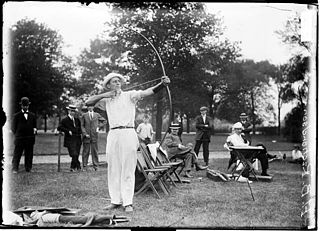
Henry Barber Richardson was an American archer. He won two Olympic bronze medals. Richardson was the first archer to win medals at two different editions of the Olympic Games as well as the youngest medallist at the 1904 Summer Olympics at the age of 15 years and 124 days.

Beatrice Geraldine Hill-Lowe was an Irish archer who represented Britain. She was born in County Louth, Ireland. She was the first Irishwoman to win an Olympic medal. She won a bronze medal at the 1908 Summer Olympics in London.

Target archery is the most popular form of archery, in which members shoot at stationary circular targets at varying distances. All types of bow – longbow, barebow, recurve and compound – can be used. In Great Britain, imperial rounds, measured in yards, are still used for many tournaments and these have slightly different rules to metric (WA) rounds, which are used internationally. Archers are divided into seniors and juniors, with juniors being those under the age of 21.

The men's team was an archery event held as part of the archery at the 2000 Summer Olympics programme.

The men's double York round event was part of the archery programme at the 1904 Summer Olympics. The event was held on 20 September 1904 at Francis Field. There were 16 competitors. George Bryant won the gold medal, with Robert Williams taking silver and William Thompson earning bronze.

The men's double American round event was part of the archery programme at the 1904 Summer Olympics. The competition was held on Monday, 19 September 1904. Twenty two archers competed. George Bryant won the competition, with Robert Williams finishing second and William Thompson third. A day later, the same three men in the same order would medal in the other 1904 Olympic archery event, the double York round.

The women's double Columbia round event was part of the archery programme at the 1904 Summer Olympics. The competition was held on Monday, 19 September 1904. Six archers competed. The event was won by Matilda Howell, the first of her three gold medals in the 1904 archery competitions. Emma Cooke and Jessie Pollock earned silver and bronze, respectively. The three women would finish in the same positions a day later in the double National round event.

The women's double National round event was part of the archery programme at the 1904 Summer Olympics. The competition was held on Tuesday, 20 September 1904. Six archers competed. The event was won by Matilda Howell, the second of her three gold medals in the 1904 archery competitions. Emma Cooke and Jessie Pollock earned silver and bronze, respectively. The three women had finished in the same positions a day earlier in the double Columbia round event.
Modern competitive archery involves shooting arrows at a target for accuracy and precision from a set distance or distances. This is the most popular form of competitive archery worldwide and is called target archery. A form particularly popular in Europe, North America, and South America is field archery, shot at targets generally set at various distances in a wooded setting. There are also several other lesser-known and historical forms, as well as archery novelty games.

The women's individual archery event at the 2012 Olympic Games was held from 27 July to 2 August 2012 at Lord's Cricket Ground in London in the United Kingdom. The event was one of four which comprised the 2012 Olympic archery programme of sports and was the eleventh time the women's individual competition was contested as an Olympic event. Forty nations qualified for the competition, sending a total of sixty-four archers to compete. The defending Olympic champion from 2008 was Zhang Juanjuan of China, who did not compete following her retirement in 2010.















